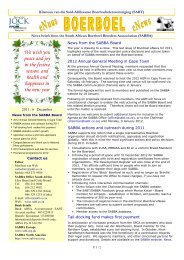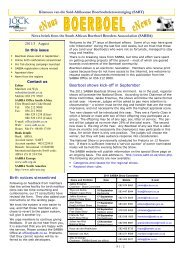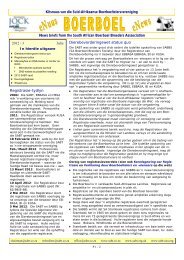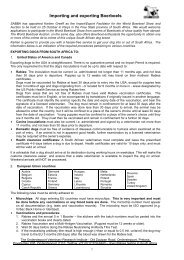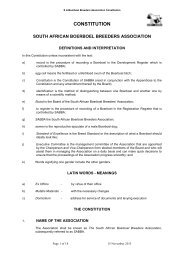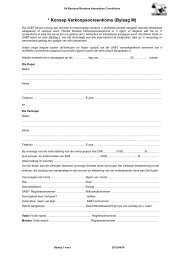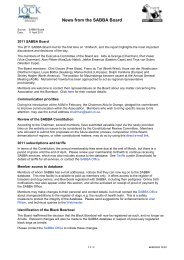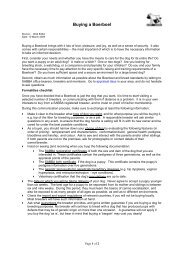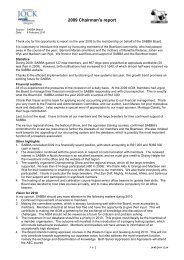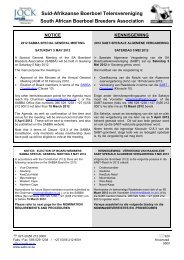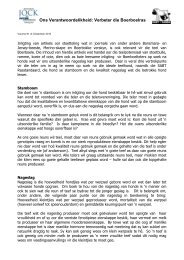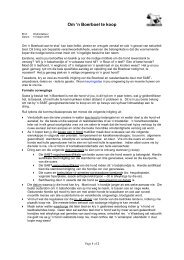History of the Boerboel - SABT
History of the Boerboel - SABT
History of the Boerboel - SABT
You also want an ePaper? Increase the reach of your titles
YUMPU automatically turns print PDFs into web optimized ePapers that Google loves.
<strong>History</strong> <strong>of</strong> <strong>the</strong> <strong>Boerboel</strong><br />
Source: Anemarí Pretorius (The <strong>Boerboel</strong> – South Africa’s own (2007)<br />
Date: 7 April 2007<br />
Someone once told me that <strong>the</strong>y had read in some dictionary or o<strong>the</strong>r that <strong>the</strong> boel part <strong>of</strong> <strong>the</strong> name<br />
<strong>Boerboel</strong> means a lot <strong>of</strong> dog. I was unfortunately unable to trace this particular definition, but if I were<br />
to create my own dictionary I am almost positive that this would be my description as well, only more<br />
so. According to <strong>the</strong> 1987 edition <strong>of</strong> <strong>the</strong> Verklarende Handwoordeboek van die Afrikaanse taal <strong>the</strong><br />
meaning <strong>of</strong> <strong>the</strong> word <strong>Boerboel</strong> is given as a farm dog <strong>of</strong> uncertain origin. This is most certainly no<br />
longer true, as I am sure you will acknowledge once you have read through this chapter.<br />
According to information portrayed in <strong>the</strong> Syrian rooms <strong>of</strong> <strong>the</strong> renowned British Museum in London,<br />
two Assyrian kings, Asarhaddon and Ashurbani-pal, were already using large dogs to hunt wild horses<br />
and lions in <strong>the</strong> 7th century before <strong>the</strong> coming <strong>of</strong> Christ. The stories depicted by <strong>the</strong>se murals in <strong>the</strong><br />
museum’s displays show that <strong>the</strong> Syrian dogs were much bigger and heavier than <strong>the</strong> dog breeds we<br />
are familiar with today. The author, Darwin, also makes mention <strong>of</strong> a large dog being shown on <strong>the</strong><br />
grave <strong>of</strong> King Asarhaddon’s son, which dates back to <strong>the</strong> year 640 BC.<br />
In one <strong>of</strong> Philemon Holland’s works, translated from Pliny’s Natural <strong>History</strong>, 1601, <strong>the</strong>re are several<br />
references to prominent persons who used large dogs for various purposes. For instance, a Germanic<br />
king who returned from exile used 200 dogges to reconquer his dominion. Reference is also made to<br />
<strong>the</strong> Cimbrians who used dogges to guard <strong>the</strong>ir belongings whilst <strong>the</strong>y where engaged in bloody<br />
battles.<br />
In <strong>the</strong> same document reference is also made to <strong>the</strong> King <strong>of</strong> Albania giving Alexander <strong>the</strong> Great <strong>the</strong><br />
gift <strong>of</strong> a dog. Alexander was very impressed with this giant animal, until he tried to use it to hunt<br />
bears, wild boar and deer – <strong>the</strong> dog did not show <strong>the</strong> least bit <strong>of</strong> interest or inclination to participate in<br />
any way. Alexander <strong>the</strong> Great, mighty king and conqueror, was livid at <strong>the</strong> dog’s “laziness” and<br />
subsequently had it destroyed. On hearing this news, <strong>the</strong> King <strong>of</strong> Albania immediately sent a<br />
replacement dog to Alexander with <strong>the</strong> instruction: “Do not waste <strong>the</strong> dog’s time with minor things.<br />
Give him a lion or an elephant to fight.”<br />
The story goes that Alexander first pitted <strong>the</strong> dog against a lion, and <strong>the</strong> lion’s back was broken within<br />
seconds <strong>of</strong> <strong>the</strong> fight starting. An elephant was next. In a panic it tried to evade <strong>the</strong> dog’s continuous<br />
attacks and ended up falling to its death down an embankment.<br />
O<strong>the</strong>r narratives <strong>of</strong> dogs killing lions are to be found in <strong>the</strong> writings <strong>of</strong> Megas<strong>the</strong>nes, Aelien, Diodorus,<br />
Siculus, Strabo and Plutarch. A monk in <strong>the</strong> service <strong>of</strong> King Louis IX <strong>of</strong> France describes (in his<br />
Travels <strong>of</strong> William de Rubruquis) how enormous <strong>the</strong> dogs <strong>of</strong> Albania were – large enough to fight<br />
against lions and bulls, and even large enough to be harnessed like oxen in front <strong>of</strong> wagons. These<br />
dogs <strong>of</strong> Syria and Albania were eventually introduced as far afield as modern Europe, <strong>the</strong> Far- and<br />
Middle East and <strong>the</strong> British Isles.<br />
Various documents explain <strong>the</strong> origins <strong>of</strong> today’s modern breeds from <strong>the</strong>se ancient dogs – from a<br />
time well before <strong>the</strong> coming <strong>of</strong> Christ. The Canis Molossus (during <strong>the</strong> time <strong>of</strong> <strong>the</strong> Roman Empire)<br />
played an important part in <strong>the</strong> derivation <strong>of</strong> modern large breeds. The activities <strong>of</strong> <strong>the</strong> Romans<br />
resulted in <strong>the</strong> importation <strong>of</strong> <strong>the</strong>se dogs to <strong>the</strong> British Isles. However, <strong>the</strong>re are major differences <strong>of</strong><br />
opinion about <strong>the</strong> order <strong>of</strong> events. Some authors are <strong>of</strong> <strong>the</strong> opinion that <strong>the</strong> Romans took this Canis<br />
Molossus to <strong>the</strong> British Isles, whilst o<strong>the</strong>rs maintain that <strong>the</strong> Romans took some English dogs back<br />
with <strong>the</strong>m to Europe. Both <strong>the</strong>se claims could well be valid.<br />
Various documents also report on trade that took place between <strong>the</strong> East and <strong>the</strong> West and, <strong>of</strong><br />
course, <strong>the</strong> British Isles. In time, our very own Cape <strong>of</strong> Good Hope inevitably became a very important<br />
sea route for trade purposes.<br />
As we have all learnt in our history lessons at school, <strong>the</strong> Verenigde Oost-Indische Compagnie (Dutch<br />
East India Company) sent Jan van Riebeeck to establish a trading post at <strong>the</strong> sou<strong>the</strong>rn tip <strong>of</strong> Africa.<br />
1
On arrival in <strong>the</strong> Cape in 1652, his trusty Bullenbijter was at his side. This was a big, strong Mastifftype<br />
breed. (Strangely enough, <strong>the</strong> bilingual dictionary <strong>of</strong> Bosman, Van der Merwe and Hiemstra,<br />
1999, indicates that <strong>the</strong> term Mastiff means, amongst o<strong>the</strong>r things, <strong>Boerboel</strong> and bul(le)byter – biter <strong>of</strong><br />
bulls.)<br />
The colonists that followed Van Riebeeck to <strong>the</strong> Cape also brought <strong>the</strong>ir biggest and strongest dogs<br />
with <strong>the</strong>m, and over time only <strong>the</strong> toughest <strong>of</strong> <strong>the</strong>se survived this new, harsh and rugged land <strong>of</strong> ours.<br />
With <strong>the</strong> arrival <strong>of</strong> <strong>the</strong> British Settlers in 1820, <strong>the</strong> Bulldog and ano<strong>the</strong>r Mastiff-type dog were also<br />
introduced, amongst many o<strong>the</strong>rs. It should be noted that <strong>the</strong> true Bull Mastiff was only imported to<br />
South Africa in 1928, by De Beers, to be guard dogs on <strong>the</strong> diamond mines. It is told that after <strong>the</strong><br />
Anglo-Boer War in 1902, <strong>the</strong>se various dog breeds were crossbred with <strong>the</strong> English long-legged<br />
Bulldog, and subsequently also with <strong>the</strong> Bull Mastiff in <strong>the</strong> late 1940’s and early 1950’s.<br />
At this point in <strong>the</strong> history <strong>of</strong> <strong>the</strong> <strong>Boerboel</strong> breed, most people would like to end <strong>the</strong> story because part<br />
<strong>of</strong> <strong>the</strong> fur<strong>the</strong>r history includes <strong>the</strong> crossbreeding <strong>of</strong> <strong>the</strong> colonists’ large dogs with <strong>the</strong> dogs (mongrels)<br />
<strong>of</strong> <strong>the</strong> black inhabitants <strong>of</strong> Africa. But, truth be told, this is how <strong>the</strong> <strong>Boerboel</strong>, as found on countless<br />
farms and which later trekked north with <strong>the</strong> Great Trek, originated.<br />
There is, however, also some interesting information available that gives rise to alternative viewpoints<br />
regarding <strong>the</strong> <strong>Boerboel</strong>’s origins. A well-known writer, E.C. Ash, claims that <strong>the</strong>re is evidence <strong>of</strong><br />
massive dogs with Mastiff-like appearance that existed during ancient Egyptian times. Ash maintains<br />
that one illustration dates as far back as 2000 BC. During <strong>the</strong> time <strong>of</strong> Kings Saul, David and Solomon,<br />
Tirus was King <strong>of</strong> Phoenicia. At this stage, a very busy trade existed between, amongst o<strong>the</strong>rs, Syria,<br />
Persia and King Solomon.<br />
All <strong>the</strong>se snippets <strong>of</strong> information seem not to mean much – until one reads <strong>the</strong> following ... <strong>the</strong> King <strong>of</strong><br />
Persia, Artaxerxes Memnon, had a private doctor in his court who was very well read and well<br />
travelled. This doctor wrote that a barbaric tribe in <strong>the</strong> south <strong>of</strong> Ethiopia (known as <strong>the</strong> Cynomones)<br />
had dogs described as Indian dogs, which were descendants <strong>of</strong> <strong>the</strong> Babylonian dog. These dogs were<br />
considered a tradeable commodity and were described as big and strong – <strong>the</strong> size <strong>of</strong> Hyrcanians and<br />
suitable for fighting lions. Pliny’s Natural <strong>History</strong> also refers to <strong>the</strong>m, but confuses <strong>the</strong>m with<br />
Cynocephali.<br />
The Cynomones bred large numbers <strong>of</strong> <strong>the</strong>se dogs to use for hunting, as well as to act as a means <strong>of</strong><br />
diverting <strong>the</strong> hordes <strong>of</strong> wildebeest that would <strong>of</strong>ten destroy <strong>the</strong> tribe’s simple shelters and o<strong>the</strong>r<br />
possessions in <strong>the</strong>ir passage and stampedes during <strong>the</strong> late-summer migrations. The Cynomones<br />
also used to milk <strong>the</strong>ir bitches, just like o<strong>the</strong>r tribes milked <strong>the</strong>ir cattle and goats – hence <strong>the</strong> name<br />
Cynomolgi (dog milkers). This information is supported by writings <strong>of</strong> Diodorus, Siculus, Aelian and<br />
Polydeuktes.<br />
Aristotle also wrote some fascinating things about this Indian dog. He said <strong>the</strong>y were a cross between<br />
a dog and a tiger, and man could only start using <strong>the</strong> third generation <strong>of</strong> this crossbreed because<br />
earlier generations were too aggressive. When on heat, bitches were tied up in remote places, but<br />
many <strong>of</strong> <strong>the</strong>m were eaten if <strong>the</strong> tigers did not feel like covering <strong>the</strong> females. It is noteworthy that Pliny<br />
repeats this selfsame information.<br />
Today, <strong>of</strong> course, we believe that it is impossible to cross a dog with a tiger. According to Aristotle, <strong>the</strong><br />
breeders <strong>of</strong> <strong>the</strong>se dogs made <strong>the</strong> most <strong>of</strong> such stories for “advertising and marketing” purposes.<br />
Never<strong>the</strong>less <strong>the</strong> Indian dog was grey or brindle. Makes one think, doesn’t it?<br />
Fur<strong>the</strong>r pro<strong>of</strong> <strong>of</strong> <strong>the</strong> Indian dog can be found in documents stemming from <strong>the</strong> time <strong>of</strong> <strong>the</strong> <strong>the</strong>n King <strong>of</strong><br />
Persia, Darius Hystaspes, who relieved four hamlets in his kingdom <strong>of</strong> all o<strong>the</strong>r work so that <strong>the</strong>y could<br />
exclusively care for (and ga<strong>the</strong>r food for) his dogs.<br />
Thus <strong>the</strong> European connection <strong>of</strong> Jan van Riebeeck with his Bullenbijter now no longer seems to be<br />
<strong>the</strong> only (or most likely) source <strong>of</strong> origin <strong>of</strong> <strong>the</strong> <strong>Boerboel</strong> – especially if we go back to <strong>the</strong> mongrels<br />
mentioned earlier.<br />
2
In time, various black African tribes moved south when <strong>the</strong>y came into contact with <strong>the</strong> Europeans –<br />
naturally <strong>the</strong>ir dogs moved with <strong>the</strong>m. A question that arises is whe<strong>the</strong>r <strong>the</strong> “African” dog with <strong>the</strong><br />
distinctive V-shape on <strong>the</strong> tail is a descendant <strong>of</strong> <strong>the</strong> dogs <strong>of</strong> Ethiopia. If so, <strong>the</strong> value <strong>of</strong> this<br />
connection could have far-reaching implications on our current level <strong>of</strong> knowledge and understanding<br />
<strong>of</strong> <strong>the</strong> make-up <strong>of</strong> <strong>the</strong> <strong>Boerboel</strong> breed.<br />
It could <strong>the</strong>refore be said that <strong>the</strong> <strong>Boerboel</strong> was bred from two main sources <strong>of</strong> genetic material, i.e.<br />
‣ <strong>the</strong> Bullenbijter from Europe, with its early roots in Albania and Syria; and<br />
‣ <strong>the</strong> African dog <strong>of</strong> <strong>the</strong> black tribes <strong>of</strong> Africa.<br />
The African dog probably descended from <strong>the</strong> Cynomones <strong>of</strong> Ethiopia, with its earlier roots in Babylon<br />
during <strong>the</strong> Persian domination, and <strong>the</strong> even earlier lineages via India back to Albania and Syria. This<br />
may also explain why <strong>the</strong> <strong>Boerboel</strong> is structurally superior to all o<strong>the</strong>r Mastiff-type dogs. The genetic<br />
material that came toge<strong>the</strong>r again in Africa has more pure, original Syrian bloodlines than any o<strong>the</strong>r<br />
breed in <strong>the</strong> world.<br />
During <strong>the</strong> period between <strong>the</strong> arrival <strong>of</strong> Jan van Riebeeck and <strong>the</strong> Great Trek (1652 – 1838) <strong>the</strong><br />
original Bullenbijter bloodline and those <strong>of</strong> o<strong>the</strong>r dogs belonging to <strong>the</strong> colonists were naturally more<br />
isolated than after <strong>the</strong> start <strong>of</strong> <strong>the</strong> Great Trek in 1838.<br />
It is fascinating to research present bloodlines back to <strong>the</strong> turn <strong>of</strong> <strong>the</strong> century or even earlier. In this<br />
way one can ascertain where certain <strong>of</strong> <strong>the</strong> old bloodlines came from, and in some instances <strong>the</strong>se<br />
can even be traced back to specific groups <strong>of</strong> trekkers who went north from <strong>the</strong> Cape.<br />
By putting all <strong>of</strong> this information toge<strong>the</strong>r one can come to <strong>the</strong> following clear conclusion: <strong>the</strong> <strong>Boerboel</strong><br />
has been bred from large and strong dogs with good characteristics. One can become almost lyrical<br />
about <strong>the</strong>se characteristics. Our forefa<strong>the</strong>rs kept <strong>Boerboel</strong>s as watchdogs, as friends and playmates to<br />
<strong>the</strong>ir children, and as protectors – a dog that would not retreat from any form <strong>of</strong> danger.<br />
Unfortunately <strong>the</strong> <strong>Boerboel</strong> has also been subjected to people who (mistakenly) thought <strong>the</strong>y knew<br />
everything, and were <strong>of</strong> <strong>the</strong> opinion that <strong>the</strong>re was a short cut to breeding <strong>the</strong> perfect <strong>Boerboel</strong>. This<br />
led to various o<strong>the</strong>r breeds being crossbred with <strong>the</strong> <strong>Boerboel</strong> line to enhance particular features,<br />
without realising that all those desired qualities were already locked into <strong>the</strong> genetic fabric <strong>of</strong> <strong>the</strong><br />
<strong>Boerboel</strong>. A lot <strong>of</strong> damage was done to <strong>the</strong> breed by this additional genetic material. Through a<br />
process <strong>of</strong> rigid breeding selection criteria, <strong>the</strong>se foreign and undesired genes will have to be bred out<br />
<strong>of</strong> <strong>the</strong> <strong>Boerboel</strong> breed again – this is our duty (yours and mine) to <strong>the</strong> <strong>Boerboel</strong> breed – in order to<br />
ennoble and enhance this wonderful indigenous breed <strong>of</strong> ours.<br />
3



